Canonic Variations on "Vom Himmel hoch da komm' ich her"
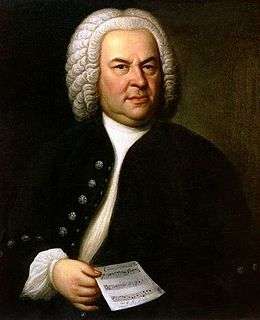
The Canonic Variations on "Vom Himmel hoch da komm' ich her" ("From Heaven above to Earth I come"), BWV 769, are a set of five variations in canon for organ with two manuals and pedals by Johann Sebastian Bach on the Christmas hymn by Martin Luther of the same name. The variations were prepared as a showpiece for Bach's entry as fourteenth member of Mizler's Music Society in Leipzig in 1747. The original printed edition of 1747, in which only one line of the canon was marked in the first three variations, was published by Balthasar Schmid in Nuremberg. Another version BWV 769a appears in the later autograph manuscript P 271, which also contains the six trio sonatas for organ BWV 525–530 and the Great Eighteen Chorale Preludes BWV 651–668. In this later version Bach modified the order of the variations, moving the fifth variation into a central position, and wrote out all the parts in full, with some minor revisions to the score.
| “ | These [variations] are full of passionate vitality and poetical feeling. The heavenly hosts soar up and down, their lovely song sounding out over the cradle of the Infant Christ, while the multitude of the redeemed "join the sweet song with joyful hearts." But the experiences of a fruitful life of sixty years have interwoven themselves with the emotions which possessed him in earlier years ... The work has an element of solemn thankfulness, like the gaze of an old man who watches his grandchildren standing round their Christmas tree, and is reminded of his own childhood. | ” | |
| — Philipp Spitta, Johann Sebastian Bach : his work and influence on the music of Germany, Vol. III, 1880. | |||
| “ | The brilliant scale passages not only represent the ascending and descending angels, but sound joyous peals from many belfries ringing in the Saviour's birth. | ” | |
| — Charles Sanford Terry, Bach's Chorals, Vol. 3, 1921. | |||
Movements

The title page of the printed version BWV 769 reads
| “ | Einige canonische Veraenderung über das Weynacht-Lied: Vom Himmel hoch da komm ich her, vor die Orgel Mit 2. Clavieren und dem Pedal von Johann Sebastian Bach Königl: Pohl: Und chur Saechss: Hoff Compositeur Capellm. u. Direct. Chor.Mus. Lips. Nürnberg in Verlegung Balth: Schmids. | ” |
In English translation this reads[1]
| “ | Some Canonic Variations on the Christmas hymn "From Heaven above to Earth I come". For organ with two manuals and pedal, by Johann Sebastian Bach, Royal Polish and Electoral Saxon Court Composer, Kapellmeister and Director of the Musical Ensemble, Leipzig. Nuremberg, published by Balthasar Schmid. | ” |
There are five variations:
- Canone all' ottava (Canon at the Octave)
 play
play - Alio Modo in Canone alla Quinta (Canon at the Fifth)
 play
play - Canone alla Settima, cantabile (Canon at the Seventh)
 play
play - Canon per augmentationem (Augmentation Canon)
 play
play - L'altra Sorte del'Canone all'rovercio, 1) alla Sesta, 2) alla Terza, 3) alla Seconda è 4) alla Nona (Canon with Inversions)
 play
play
In BWV 769a, the variations occur in the modified order 1, 2, 5, 3, 4.
History and origins
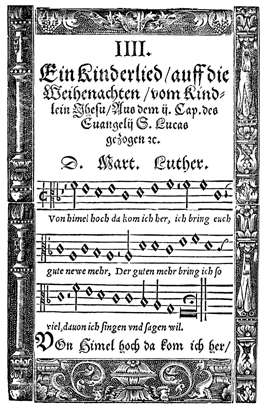
In June 1747 he entered the Society for the Musical Sciences ... He presented to the Society the chorale "Vom Himmel hoch da komm' ich her" completely worked out, and this was afterwards engraved in copper.[2]
In June 1747, Bach was admitted as the fourteenth member of the "Correspondierde Societät der Muscialischen Wissenschaften" (Corresponding Society for the Musical Sciences), a society devoted to musical scholarship founded in Leipzig in 1738 by Lorenz Christoph Mizler. To mark his admission he not only presented a version of the Canonic Variations, but also a portrait by Elias Gottlob Haussmann in which Bach holds a copy of his canon triplex a 6 voci BWV 1076 towards the viewer. During the last ten years of his life, Bach had become preoccupied musically with canons and canonic fugues, already much developed in the Parts III and IV of the Clavier-Übung – the Organ Mass BWV 552, BWV 669–689, the four canonic duets BWV 802–805 and the Goldberg Variations BWV 988 – as well as the Musical Offering BWV 1079 and the Art of the Fugue BWV 1080. The triplex canon itself became part of the Fourteen Canons BWV 1087, preserved in one surviving copy of the Goldberg Variations. Mizler seems to have been unaware of the numerological significance that the number fourteen had to Bach (B+A+C+H=14).[4]
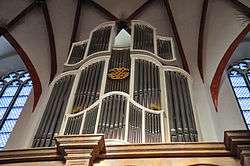

The Canonic Variations are based on the Christmas Hymn "Von Himmel hoch, da komm ich her" for which the words and melody were composed in 1539 by Martin Luther. The chorale itself was set three times by Bach in his Christmas Oratorio, BWV 248, and again as an addition for Christmas in his Magnificat in E-flat major, BWV 243a. Bach had already used the cantus firmus in earlier chorale preludes, notably BWV 606 (Orgelbüchlein), 700, 701 and 738, with accompanying motifs above and below the melodic line that were to recur in BWV 769. There are also similarities with several of the Goldberg Variations, notably the third and thirteenth, with shared motifs, keyboard technique and general structure. In the case of the earlier harpsichord work, however, the variations are written over a fixed bass line, while BWV 769 is based on a melody.
During this period Bach had been criticized vociferously by the Danish composer Johann Adolph Scheibe for producing music that was too old-fashioned, abstract and artificial. Scheibe had described Bach's output as "altogether too much art" and had referred to the canons as outmoded follies ("Thorheiten"). However, despite the logic of the canon that underlies the Canonic Variations, Bach succeeded in producing a work which, far from being abstract and severe, was imbued with an affect of "beauty" and "naturalness", quite modern for its time and in keeping with the spirit of galante music.[5] The musical language of Bach in BWV 769 is as different from his other organ music as that of the Goldberg Variations is from his earlier harpsichord music. Combining complex counterpoint with the spiritual associations of Advent and Christmas, Bach's harmony and keyboard technique produce a musical style "at times strangely new, at others very approachable" yet "elusive enough to prompt admirers to search outside music for suitable expressive metaphor." As Williams (2003), p. 518 puts it, the "canons create harmonies, melodies and progressions not only otherwise unheard but strangely rapt and intense."
Various stylistic elements in the Canonic Variations recall the compositions of Bach's predecessors and contemporaries. The running figures in the first variation can be found in Toccata No.12 of Georg Muffat (1690) and in the keyboard sonatas of Domenico Scarlatti. The canon in the second variation is close in spirit to the Canons Mélodieux for two instruments of Georg Philipp Telemann. The galant figures of the free line in the third variation are similar to those promoted by Joachim Quantz in his 1752 treatise on flute playing. The elaborate ornamentation of the fourth variation uses many devices from his son Carl Philipp Emanuel Bach's treatise on keyboard technique (1753, 1762); the final pedal point harks back to those of the chorale preludes of Dieterich Buxtehude, for example in his setting of "Durch Adams Fall ist ganz verdebt", BuxWV 183. The walking pedal-bass beneath the canon at the beginning of the fifth variation is similar to Georg Friedrich Kaufmann's setting of "Vom Himmel hoch" in his Harmonische Seelenlust (c. 1733).[6][7]
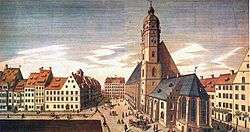
Butler (2000) has examined the surviving manuscripts in detail to determine the manner in which the Canonic Variations were composed and published. They seem to have been composed, not necessarily in their final form, in 1746 or at least for the New Year's Fair of 1747. In the engraved version the first three, written in annotated form, could not be performed directly from the copy, since only one part of the canon was provided, the other having to be worked out "with the pen at home". The engraved version was also probably devised to minimize page turns and economize on space, so the combination of these factors speaks against any particular significance in the order of the movements. It is also not clear which of the remaining two canons was prepared specially for Mizler's Society. The exuberant Canon with Inversions, which appears last in the engraved version, builds up to a cumulative climax, but originally did not contain the passing reference to the BACH motif in its closing bars. In the autograph manuscript, it becomes the central variation, comparable to the role played by the central large-scale sixteenth Goldberg variation. The calmer Augmentation Canon, on the other hand, similar to the thirteenth Goldberg variation, has a clear reference to the BACH motif in its 39th bar, its anguished harmonies resolved peacefully by the final pedal point. Because of continual reworkings, it is now believed that Bach never intended there to be a final fixed version. Commentators have pointed out that although the order of the variations in the autograph version gives it a certain aesthetic symmetry, the order in the engraved version might be more appropriate for performance.[8]
Musical structure
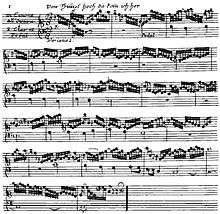
Variatio I

The two part canon is a derived from the first and last line of the cantus firmus. The descending scale with which it starts is similar to the accompanying figures in Chrise, du Lamm Gottes, BWV 619, of the Orgelbüchlein. They have been interpreted as representing Christ's descent from Heaven to Earth. The graceful introductory ritornello is recapitulated before the last line of the pedal cantus firmus, played in the tenor register with an 8' stop.
Variatio II


The two part canon is based on the first and second lines of the cantus firmus. As in Variatio I, there is a recapitulation in syncopated form of the opening ritornello before the last line of the cantus firmus, which has the same registration. The ascending scales above the pedal point at the close have been interpreted as departing angels or the elevation of the soul.
Variatio III

The canon occurs in the two lower voices over which the alto part plays a free melody, with the cantus firmus in the soprano. The canon takes the form of an ostinato ritornello derived form the first line of the cantus firmus with interludes when the cantus firmus recurs. The expressive alto part, marked cantabile with elaborate ornamentation, melismatic passages and occasional dissonant appoggiaturas, resembles the solo part in an aria. It also has similarities with the figurations in the solo line of the slow movement of the F minor harpsichord concerto, BWV 1056. In bar 19, the chromaticism of the two canonic parts evoke the dragging of the cross; the tensions of this episode are gradually resolved as the variation comes to a peaceful and harmonious close.
Variatio IV
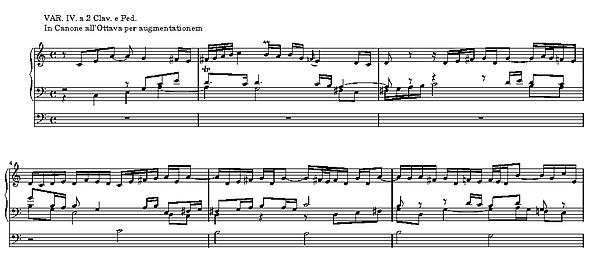
This variation takes the form of a newly composed melismatic arioso solo line in the right hand followed in canon by the bass of the left hand at half the speed. Between these two parts is a free alto line, with tenor cantus firmus in the pedal. The free alto line sometimes rises above the soprano line, creating a "halo" effect. All three manual parts derive from elements of the cantus firmus. When these occur in the elaborate and unusual soprano line, these provide apparently new ways of hearing the melody of the chorale. The compositional style, particularly of the wide ranging right hand solo part, is similar to that of the thirteenth Goldberg variation. The opening phrase recurs as a sort of ritornello in diminution in bar 34. Above the fourth line of the cantus firmus, the right hand weaves an elaborate coloratura line. In the middle parts the slower dragging motif recurs coming to a climax in the second part of bar 39 with the BACH motif in the alto part, before the peaceful coda, with elegiac piping motifs repeated over a pedal point:
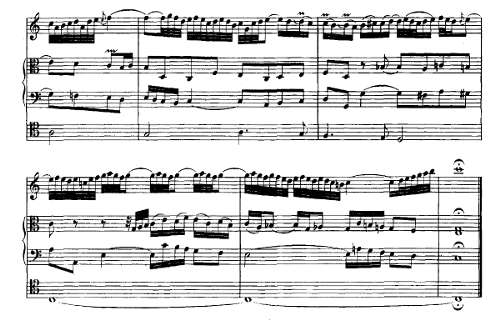
Variatio V

In this variation, the canon is the melody of the chorale itself. It has three sections, the first and second further subdivided in two, building up to a grandiose and complex climax in the final bars of the third section. In the first section, the two manual parts play the chorale line by line in inverted canon over a walking bass continuo stamped out in the pedal, first at an interval of sixth and then a third. In the second and third sections, the pedal part returns to the smooth lines of the cantus firmus.

In the second section, the pedal and the separate hands again play the chorale line by line in inverted canon, separated by an interval of a second and then a ninth, with a free imitative part in the hand playing the canon and a free running semiquaver part in the other hand. The semiquavers occur first in the right hand with the imitative part above the left hand; then in the left hand with the imitative part this below the canon. The musical texture is similar to that used previously in Vom Himmel kam der Engel Schar, BWV 607, from the Orgelbüchlein, another chorale prelude for advent on the theme of descending angels.

In the last section, marked forte, the pedal part plays the last line of the cantus firmus, with the first line in true and inverted forms in diminutio above it. The variation culminates over the closing pedal point with a stretto of all four lines, again with inversions and diminutio. (At this point the manual parts, move to one keyboard.) The supposed occurrence of the BACH motif shared between the two inner manual parts in the last bar did not occur in the original printing of BWV 769, where there is B flat (B in German) instead of a B natural (H in German); this was modified by editors in later editions.
Text and translation
Below is the original text from 1539 by Martin Luther with the English translation from 1855 of Catherine Winkworth:

|
|
|
|
|
|

|
|
|
|
|
|
|
|
|
|
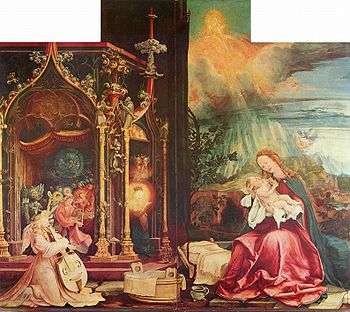
|
|
|
|
|
|
|
|
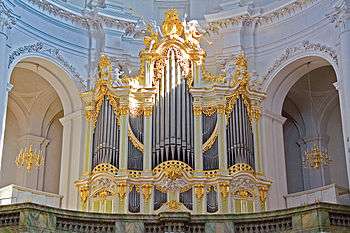
|
|
|
|
|
|
Reception
The Canonic Variations were among the works included in J. G. Schicht's four-volume anthology of Bach's organ music (1803–1806), prior to the publication of Bach's complete organ works in 1847 by Griepenkerl and Roitzsch in Leipzig. Felix Mendelssohn, Robert Schumann and Johannes Brahms all studied the Variations, annotating their personal copies of Schicht. Mendelssohn himself composed a 6 movement cantata on "Vom Himmel hoch" in 1831 for soprano, baritone, mixed choir and orchestra, opening with the same descending figures as those in Bach's Variation 1.[10]
Transcriptions
- Ivan Karlovitsch Tscherlitzky (1799–1865), organist in the Maltese Chapel adjoining the Vorontsov Palace in St Petersburg, arranged the Canonic Variations for piano solo.[11]
- In 1951 and 1958 the Swiss organist, conductor and composer Roger Vuataz (1898–1988) made two arrangements of the Canonic Variations for orchestra.[12]
- In 1956 Igor Stravinsky made an arrangement of the Canonic Variations for orchestra and mixed choir, adding extra contrapuntal lines.[13]
Selected recordings
- Bernard Foccroulle, Leipzig Chorales, Ricercar, RIC212 (2 discs). Recorded in 2002 on the large Silbermann organ in Freiberg Cathedral, Germany, dating from 1714. Th|yer recording also includes the Preludes and Fugues BWV 546 and 547 and the Great Eighteen Chorale Preludes.
- André Isoir, L'Oeuvre pour Orgue (15 discs), Calliope, CAL 3703–3717 (budget edition 2008). The Canonic Variations and the Great Eighteen Chorale Preludes, recorded in 1990 on the G. Westenfelder organ in Fère-en-Tardenois, are contained on the last 2 discs, which are available separately.
- Ton Koopman, Bach Organ Works, Volume 5, Teldec, B00000JHHD. Recorded in 1997 on 2 discs with Part III of the Clavierübung.
- Helmut Walcha, Bach Great Organ Works, Deutsche Grammophon, 2 disc set remastered from recordings between 1947 and 1950.
Notes
- ↑ Williams 2003, p. 513
- ↑ In die Societät ist er in Jahr 1747 Junius .. ... etreten ... Zur Societät hat er den Choral geliefert: Vom Himmel hoch da komm' ich her, vallständig ausgearbeitet, der hernach in Kupfer gestochen werden.
- ↑ Bach CPE, Agricola F. Nekrolog auf Johann Sebastian Bach. Vol 4, pt 1. Leipzig, Germany: LC Mizler Muzikalische Bibliothek; 1754.
- ↑ Williams 2003, pp. 512–516
- ↑ Yearsley 2002, pp. 112–113
- ↑ Williams 2003
- ↑ Yearsley 2002
- ↑ Williams 2003, p. 516
- ↑ Williams 2003, p. 516
- ↑ Stinson 2006
- ↑ Bach-Tscherlitzky arrangements on www.bach-cantatas.com
- ↑ Bach-Vuataz arrangements on www.bach-cantatas.com
- ↑ Strauss, Joseph N. (1986), "Recompositions by Schoenberg, Stravinsky and Webern", Musical Quarterly, LXXII (3): 301–427, doi:10.1093/mq/lxxii.3.301
References
- Barber, Elinore (1986), Clavierübung Part IV (Goldberg Variations) BWV 988 and the Canonic Variations BWV 769, Riemenschnedier Bach Facsimiles, 2
- Butler, Gregory G. (1990), J. S. Bach's Clavier-Ubung III : The Making of a Print, with a Companion Study of the Canonic Variations on Vom Himmel Hoch BWV 769, ISBN 9780822310099
- Butler, Gregory G. (2000), "J. S. Bachs Kanonische Veränderungen über "Vom Himmel hoch" (BWV 769). Ein Schlußstrich unter die Debatte um die Frage der "Fassung letzter Hand"", Bach-Jahrbuch, 86: 9–34
- Stinson, Russell (2006), The reception of Bach's organ works from Mendelssohn to Brahms, Oxford University Press, ISBN 0195171098
- Williams, Peter (2003), The Organ Music of J. S. Bach (2nd ed.), pp. 512–524, ISBN 0521891159
- Yearsley, David Gaynor (2002), Bach and the meanings of counterpoint, New perspectives in music history and criticism, 10, Cambridge University Press, ISBN 0521803462
External links
- Canonic Variations on "Vom Himmel hoch da komm' ich her": Scores at the International Music Score Library Project
- Free score at Mutopia
- Free creative commons downloads of the Canonic Variations recorded by James Kibbie on the 1755 Gottfried Silbermann/Zacharias Hildebrandt organ in the Katholische Hofkirche, Dresden, Germany: BWV 769/i, BWV 769/ii, BWV 769/iii, BWV 769/iv, BWV 769/v.
| Wikimedia Commons has media related to Canonic Variations on "Vom Himmel hoch da komm' ich her". |
